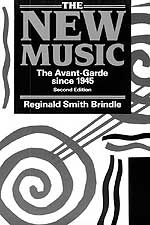The New Music - The Avantgarde Since 1945 Book
This highly inspired, intelligent and concise look at the experimental fringes of modern music is still a very good introduction to musical ideas and concepts beyond the confinement of traditional songwriting. A special chapter is dedicated to electronic music and its influence on the music of today and tomorrow.
Reginald Smith Brindle, himself a renowned guitarist and daring composer, has published a couple of books on musical and serial composition and on woodwind instruments. "The New Music" is a very successful attempt to provide a guide to the most challenging works and techniques in modern music since 1945.
This book is by no means a traditional encyclopedia trying to list each and every detail or even biographies and discographies - the author has well developed a thread throughout the book, and he has accomplished that by leaving out anything that would unnecessarily bloat the contents, while adding useful information about the historical and social background of trends in challenging music.
The first edition of "New Music" was published in 1975, the second, updated, edition in 1987. Seems like ages ago, but still this book provides a very good overview and doesn't seem dated at all. Whether that's due to Smith Brindle's massive knowledge about music that would almost certainly provide him with a look into the future, or simply to the fact that there hasn't been much radical change in modern music over the past few decades, is up to the reader.
However, even the chapter on electronic and computer music still seems up to date, though written more than 15 years ago. The timeless quality of this book stems from the fact that Smith Brindle always stays close to facts and basics - and the basics, of course, never change that much. Another achievement that makes this book worthwhile reading is the fact that the author has succeeded in presenting even the most complex topic in such a way as not only trained composers and musicians will be able to understand.
A lot of illustrations and excerpts from original scores give additional visual information, which of course is especially useful in the discussion of alternative "notation" like text and graphic scores, routing diagrams of synthesizers, or the opposition of the rigid structure of serial composition to the free form of aleatory music. Special mention is given to the influence of archaic and oriental structures (Smith Brindle calls it "The Search Outwards"), Musique Concrete and the works of John Cage and Stockhausen.
A very informative book indeed, and well written, too. Here's an excerpt from Chapter 1:
"This is a mechanistic age in which technology is rocketing ahead, leaving a wake of social ills and spiritual disorders. Man, in his real essence, is hardly better off than the cave dwellers of 40000 years ago, in spite of all his technological benefits. Nevertheless, though we may protest, this is the life we all live. The sound of machines is part of our existence, and inevitably the same kind of sound has become an integral part of our music." (Reginald Smith Brindle)
(rh)
Published by Oxford University Press

"The New Music", a concise guide to the fringes of modern music